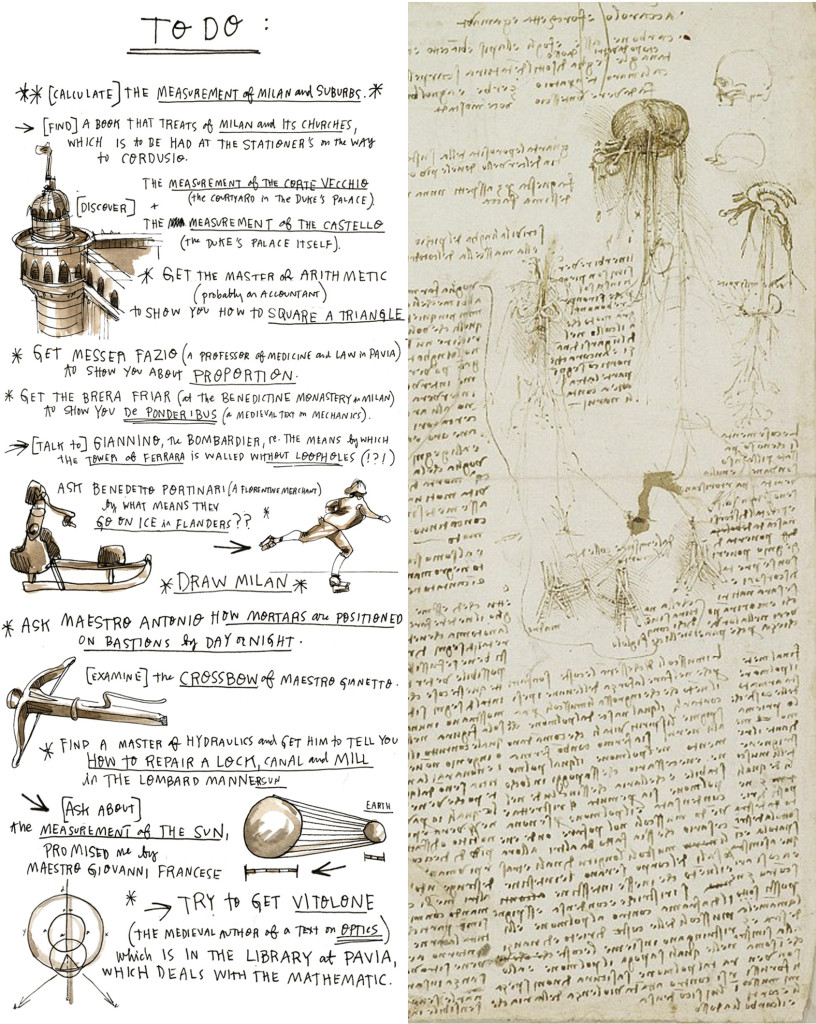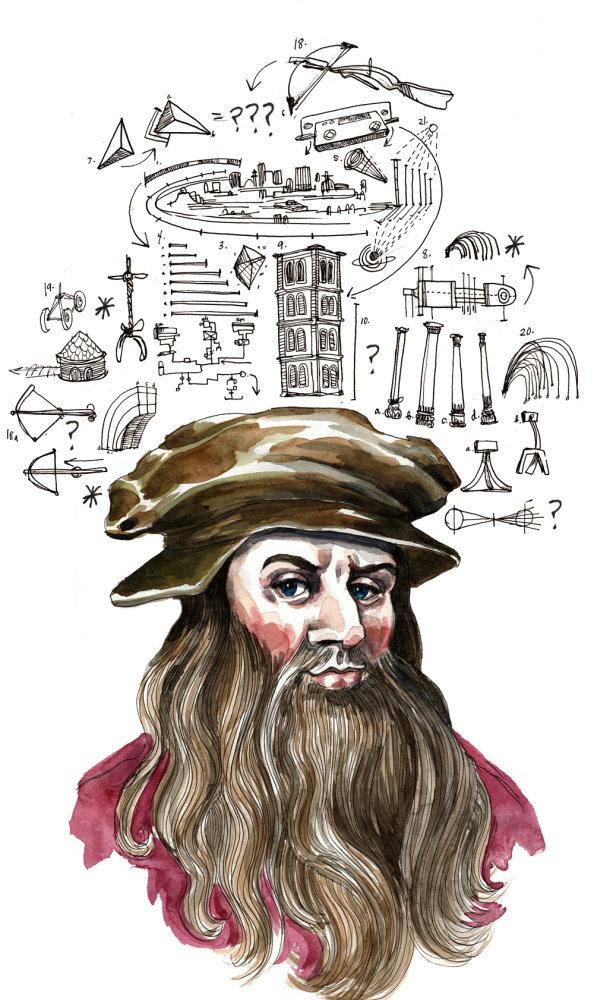Have you ever wanted an inside look into a geniuses mind? Possibly get a glimpse into how they think or what they wanted to do? Well luckily for us, historian Toby Lester provides us with such an opportunity.
After searching through one of Da Vinci’s journals, which he often used as a commonplace book of sorts, Lester found a page that seemed to be a to do list for a week or month, back in the 1490’s.
Below is an illustration of what that to do list looked like, as well as a glimpse at the original.

Illustration (left) by Wendy MacNaughton. Original (right) from Da Vinci’s notebook
If you couldn’t decipher the whole thing, you can find it listed out below (brackets are the authors additions):
- [Calculate] the measurement of Milan and Suburbs
- [Find] a book that treats of Milan and its churches, which is to be had at the stationer’s on the way to Cordusio
- [Discover] the measurement of Corte Vecchio (the courtyard in the duke’s palace).
- [Discover] the measurement of the castello (the duke’s palace itself)
- Get the master of arithmetic to show you how to square a triangle.
- Get Messer Fazio (a professor of medicine and law in Pavia) to show you about proportion.
- Get the Brera Friar (at the Benedictine Monastery to Milan) to show you De Ponderibus (a medieval text on mechanics)
- [Talk to] Giannino, the Bombardier, re. the means by which the tower of Ferrara is walled without loopholes (no one really knows what Da Vinci meant by this)
- Ask Benedetto Potinari (A Florentine Merchant) by what means they go on ice in Flanders
- Draw Milan
- Ask Maestro Antonio how mortars are positioned on bastions by day or night.
- [Examine] the Crossbow of Mastro Giannetto
- Find a master of hydraulics and get him to tell you how to repair a lock, canal and mill in the Lombard manner
- [Ask about] the measurement of the sun promised me by Maestro Giovanni Francese
- Try to get Vitolone (the medieval author of a text on optics), which is in the Library at Pavia, which deals with the mathematic.
It’s quite the list and there are a few things we can infer from what we see here.
1. Da Vinci Followed His Curiosity
The array of thoughts and ideas here is pretty incredible. From his various measurements of the city to drawing all of Milan to understanding how to square a triangle, it’s broad and scattered.
If there’s one thing we can say, Da Vinci followed his curiosity wherever it took him. Calling him the ultimate Renaissance Man certainly doesn’t fall short from this perspective.
2. Da Vinci Utilized Experts
A key approach by Da Vinci was that he didn’t act as if he knew everything. He realized that other experts knew certain things far better than he, so he sought them ought to acquire new knowledge.
He would travel far and frequently to pick the brain of a wide range of people, from medical professors to fellow authors and inventors. If he didn’t understand something, he found people that did.
3. Da Vinci Didn’t Focus
Despite being a master painter, Da Vinci clearly didn’t focus on just his painting. He was as unfocused as they come and explored a broad range of things on a regular basis. If you look at this list, only maybe the drawing of Milan falls into the artist bucket.
This wasn’t just a way to procrastinate though. The benefits of a wandering mind can unlock our creativity and give us a break from our more intense work. Perhaps we can take a page out of Da Vinci’s book and realize that being distracted by things that catch our curiosity is actually a worthy endeavor.
Time abides long enough for those who make use of it.Leonardo Da Vinci
What would Da Vinci do if he were alive today? He’d certainly save a lot of time.
At the time, the things that Da Vinci spent his time on were legitimately taxing endeavors that required real effort. What’s crazy is that our smartphones can empower us to accomplish 90% of these tasks quite easily.

Illustration by Wendy MacNaughton
The ability to communicate with people across the world, let alone within Italy would save hundreds of travel hours alone. Furthermore, being able to query specific information in seconds would quench many of his random curiosities.
Many argue that the way of the generalist is out of reach today, simply because of how vast information and knowledge has grown over the years. I believe the opposite. I think that technology has kept pace to allow us to continue to follow this path if we so choose, and do so wisely.
The opportunities we have today are incredible. We have become empowered to create and be creative if we choose to. On top of that, we can learn from anyone and everyone, whenever we desire. Sure, there will always be more to learn than possible, but that shouldn’t deter us from chasing knowledge constantly.
If Da Vinci is happy to travel 200 miles from Florence to Milan, just to learn about mechanics because it interests him, what excuses do we have not to hop online and explore a new subject?
Follow your curiosity, always be learning, wander a bit, and discover how amazing the world truly is.
